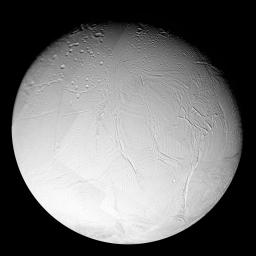
|
Enceladus: Trailing Hemisphere
- Click the image above for a larger view
- Full-Res JPEG (8804 x 8804) (3.7 MB)
- Full-Res TIFF (8804 x 8804) (77.5 MB)
Caption:
A variety of surface ages is revealed in this 16-image mosaic taken during Cassini's first close flyby of Enceladus, on Feb. 17, 2005.
This mosaic shows the trailing hemisphere of Enceladus -- the side of Enceladus that always faces away from the direction of the satellite's orbital motion. This hemisphere is dominated by Sarandib Planitia (just right of center), a region thought to be dominated by smooth plains in NASA Voyager 2 images taken in August 1981, but shown here in much higher resolution images to be covered in low ridges and troughs. Other major features seen in the region include Labtayt Sulci, a 1-kilometer- (0.6-mile-) deep canyon running northward from a cusp in the south polar terrain boundary (Cashmere Sulci) at lower right to a set of 1-kilometer-tall ridges (Cufa Dorsa and Ebony Dorsum) east of Sarandib Planitia (also seen in PIA06191 ), as well as Samarkand Sulci, a band of ridges and troughs running along the western margin of Sarandib Planitia almost all the way north to Enceladus' north pole.
In contrast to the youthful terrain of Sarandib Planitia and the terrain south of it, the terrain north and west of Sarandib appears much older. These regions are covered with impact craters at various stages of degradation, either from viscous relaxation (which causes the craters to flatten over time), or from tectonic activity.
To create this single full-disk mosaic, the 16 images were reprojected into an orthographic projection centered at 2.3 degrees north latitude, 317.7 degrees west longitude with a pixel scale of 63 meters (207 feet) per pixel. The original images were taken by the Cassini spacecraft narrow-angle and wide-angle cameras from distances ranging from 10,850 to 29,750 kilometers (6,740 to 18,490 miles). The images had a phase, or sun-Enceladus-spacecraft, angle of 28 degrees.
Background Info:
The Cassini-Huygens mission is a cooperative project of NASA, the European Space Agency and the Italian Space Agency. The Jet Propulsion Laboratory, a division of the California Institute of Technology in Pasadena, manages the mission for NASA's Science Mission Directorate, Washington, D.C. The Cassini orbiter and its two onboard cameras were designed, developed and assembled at JPL. The imaging operations center is based at the Space Science Institute in Boulder, Colo.
For more information about the Cassini-Huygens mission visit http://saturn.jpl.nasa.gov/home/index.cfm . The Cassini imaging team homepage is at http://ciclops.org .
Cataloging Keywords:
| Name | Value | Additional Values |
|---|---|---|
| Target | Enceladus | |
| System | Saturn | |
| Target Type | Satellite | |
| Mission | Cassini-Huygens | Voyager |
| Instrument Host | Cassini Orbiter | |
| Host Type | Orbiter | Flyby Spacecraft |
| Instrument | Imaging Science Subsystem (ISS) | |
| Detector | Narrow Angle Camera, Wide Angle Camera | |
| Extra Keywords | Crater, Grayscale, Impact, Visual | |
| Acquisition Date | ||
| Release Date | 2006-12-29 | |
| Date in Caption | 2005-02-17 | |
| Image Credit | NASA/JPL/Space Science Institute | |
| Source | photojournal.jpl.nasa.gov/catalog/PIA08353 | |
| Identifier | PIA08353 | |
